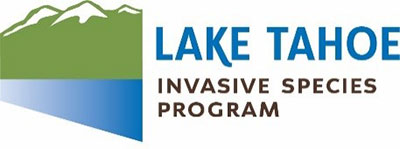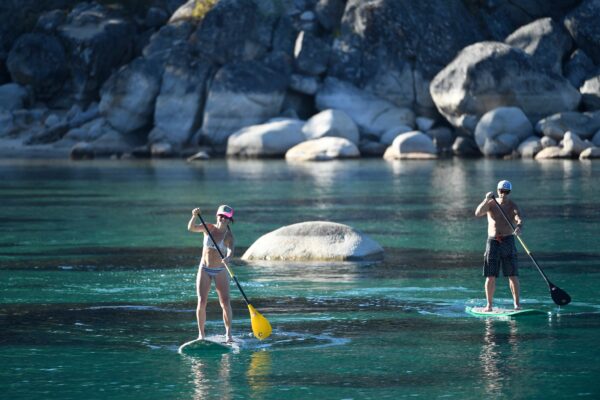NEWS RELEASE
Contact: Cheyanne Neuffer
cneuffer@tahoercd.org
Inspections are required for powerboats, here is what is different about kayaks, paddleboards or electric surfboards
Lake Tahoe, CA/NV – As summer in the Tahoe Basin begins to ramp up, boating does as well. Most boaters know their vessel needs to be inspected at a watercraft inspection station prior to launching. The Clean, Drain, and Dry protocol is universally seen and understood throughout the region. The process ensures that no new aquatic invasive species are introduced to the lake — and none have since inspections began in 2008.
But, what about kayaks, paddle boards, sailboats, rafts, or even electric foil boards (Efoils) – do they need an inspection? Well, here is any easy guide to see if you need to come by a watercraft inspection station for a free, non-motorized inspection.
NON-TRAILERED AND NON-MOTORIZED
Non-trailered, non-motorized watercraft are not required to have an inspection but “may be subject to inspection prior to entering the waters of the Lake Tahoe region if determined necessary” (TRPA Code 63.4.2) depending on the posed risk.
In order to assess risk, be prepared to answer some questions about your boating history at state parks, kiosks, launching areas and public beaches. If you are coming from a water body that is deemed high-risk for the spread of invasive species, you will be directed to an inspection station to get a free inspection and possible decontamination.
For example, if you are coming from Lake Mead or Havasu, a free inspection and decontamination would help alleviate the risk of introducing Quagga or Zebra mussels into regional waters.
For pristine waters that have no invasive species, such as Echo Lakes, Angora, and Fallen Leaf lakes, even Lake Tahoe is considered a threat from the Eurasian watermilfoil, curlyleaf pondweed, and Asian clams currently found there. Decontaminations prior to using non-motorized watercraft in pristine waters help keep them pristine, and, as always, are prioritized and free at watercraft inspection stations.
If your non-motorized watercraft is covered in water or mud, or is just dirty, you may be asked by recreation officials to go to an inspection station and get a decontamination. If the watercraft is not coming from a high-risk waterbody and is completely Cleaned, Drained and Dry, you can launch wherever you like in Lake Tahoe.
TRAILERED NON-MOTORIZED
If your watercraft is large enough that it needs to be on a trailer, then it will need to be inspected. This does not apply to basic utility trailers. After the inspection, watercraft will get a free non-motorized Tahoe In & Out sticker.
OTHER WATERCRAFT
The official code states, all motorized watercraft need an inspection. Does your Efoil or electric surfboard have an electric or gas-powered motor? If so, then it needs to go to an inspection station. Luckily, inspections are free for most electric motors, so you won’t need to pay for the inspection.
BECOME A TAHOE KEEPER
Tahoe Keepers are people who actively use a non-motorized watercraft in the Tahoe Basin, have pledged their stewardship of the Tahoe Region and have shown their knowledge of Clean, Drain and Dry procedures. Tahoe Keepers are paddling stewards who protect the region’s waters and lead by example. To become a Tahoe Keeper, visit tahoekeepers.org, take the quiz and then you will receive your decal and certificate in the mail.
Remember, the best way to stop the spread of aquatic invasive species is to Clean, Drain and Dry all watercraft when leaving or entering another water body. Lake Tahoe’s regional waters remain crystal clear for a reason – we all work diligently to preserve the beauty and ecology of the Lake Tahoe Basin.
Non-motorized boaters are welcome to stop by the inspection stations any time for free inspections to make sure they have no delays at the launching areas. For a list of inspection stations or to book an appointment for a motorized mandatory inspection, please visit our website.
###
 The Lake Tahoe Aquatic Invasive Species Program is implemented by 40 public and private partner organizations, including federal, state, and local jurisdictions, research partners, public utility districts, and private marinas. The Tahoe Regional Planning Agency and the Tahoe Resource Conservation District lead the program in collaboration with the public and private partners. The program’s mission is to prevent, detect, and control aquatic invasive species in the Region so that future generations can enjoy Lake Tahoe. For additional information, contact cneuffer@tahoercd.org.
The Lake Tahoe Aquatic Invasive Species Program is implemented by 40 public and private partner organizations, including federal, state, and local jurisdictions, research partners, public utility districts, and private marinas. The Tahoe Regional Planning Agency and the Tahoe Resource Conservation District lead the program in collaboration with the public and private partners. The program’s mission is to prevent, detect, and control aquatic invasive species in the Region so that future generations can enjoy Lake Tahoe. For additional information, contact cneuffer@tahoercd.org.

